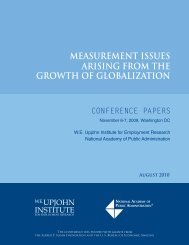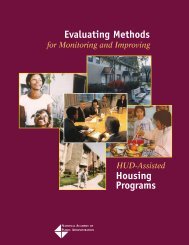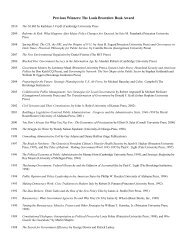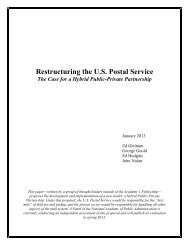High-Performance Partnerships - National Academy of Public ...
High-Performance Partnerships - National Academy of Public ...
High-Performance Partnerships - National Academy of Public ...
You also want an ePaper? Increase the reach of your titles
YUMPU automatically turns print PDFs into web optimized ePapers that Google loves.
HFP is an excellent model <strong>of</strong> growing a partnership to scale.The major<br />
milestones in establishing and expanding it were:<br />
• September 1991:<br />
• September-November 1991:<br />
•November 1991:<br />
• December 1991:<br />
• August 1992:<br />
• December 1994:<br />
• March 1997:<br />
•July 1998:<br />
•July 1999:<br />
•July 2001:<br />
Decision to act<br />
Research best practices<br />
Partnership review <strong>of</strong> research<br />
Partnership selects approach<br />
First efforts launched<br />
All services available<br />
Decision to go to scale<br />
Title IV-E Funding awarded<br />
Full-scale funding achieved<br />
Service capacity reaches scale<br />
During its first year, Healthy Start enrolled 135<br />
clients, and Healthy Communities similarly<br />
reached only a fraction <strong>of</strong> the community. By<br />
2001, 30,000 <strong>of</strong> the city’s 35,000 children<br />
received one or more <strong>of</strong> these services.<br />
Challenges<br />
HFP’s road to success was not always smooth.<br />
Initial challenges included achieving widespread<br />
consensus on organizational structure. Hampton<br />
was concerned that quick, decisive action was<br />
needed to meet mission critical objectives. It felt<br />
only key investors could marshal the required<br />
resources. Therefore, the investor model was<br />
chosen as a more appropriate format than the<br />
stakeholder approach.<br />
Because the partnership was focused on longterm<br />
outcomes, readily available data were difficult<br />
to obtain. HFP was willing to measure its<br />
success on outcomes not completely within its<br />
own purview, such as educational outcomes for<br />
children. Meaningful outcomes are the soul <strong>of</strong> a<br />
high-performance partnership, and Hampton<br />
certainly has met that test.<br />
Keys to Success<br />
Partners identified several success factors.<br />
HFP’s action-oriented leadership focused on<br />
strategic goals and long-term outcomes, and the<br />
partners perceived their common mission as a<br />
“win-win.” Another factor was that Hampton<br />
faced a budget crisis with potentially serious<br />
consequences for service delivery, making creative<br />
solutions all the more critical. Meanwhile,<br />
Hampton’s environment was very conducive to<br />
partnering; participant trust was integrated into<br />
the city’s organizational culture.<br />
According to the partners, another key success<br />
factor has been the ability to redefine service<br />
delivery strategies and redirect resources.<br />
Solutions are not “business as usual” or<br />
focused on “throwing money at a problem.”<br />
Instead, the partnership has changed how the<br />
community serves at-risk children and families.<br />
Rather than react to health and educational<br />
problems once a child enters school,<br />
HFP seeks to prevent them from occurring in<br />
the first place. It has institutionalized a comprehensive<br />
approach to family intervention as<br />
early as the pre-natal stage.<br />
41 Powering the Future: <strong>High</strong>-<strong>Performance</strong> <strong>Partnerships</strong>









